October 21, 2025

Continuous reinforcement in ABA therapy stands as a fundamental behavioral principle, wherein a desired action is reinforced every time it occurs. This method is crucial for establishing new behaviors. It provides immediate feedback, consistency, and clarity, effectively shaping responses and enhancing learning. Particularly in early intervention settings for individuals with developmental disabilities, its impact is profound. By employing this technique, practitioners can ensure that the learning process is not only efficient but also tailored to meet the unique needs of each individual.
In the realm of Applied Behavior Analysis (ABA), the concept of continuous reinforcement stands as a cornerstone for effective behavior modification. This approach not only fosters the development of new skills but also ensures that individuals receive immediate and consistent feedback, reinforcing positive actions. As practitioners navigate the complexities of behavior analysis, they may ponder: how can the principles of continuous reinforcement be optimally applied to maximize learning outcomes? This inquiry is particularly relevant for addressing the unique challenges faced by individuals with developmental disabilities. Exploring this question reveals the profound impact that continuous reinforcement can have on shaping behaviors across various environments.
In Applied Behavior Analysis (ABA), continuous reinforcement refers to a fundamental behavioral principle where a desired action receives reinforcement each time it occurs. This method proves particularly effective for fostering new behaviors, as it provides immediate feedback to the individual, thereby reinforcing the connection between the action and its positive outcome.
For example, when a child receives praise every time they complete their homework, this consistent reinforcement encourages them to repeat the behavior in the future. Such ongoing support is crucial in establishing behaviors, especially during the initial stages of learning.
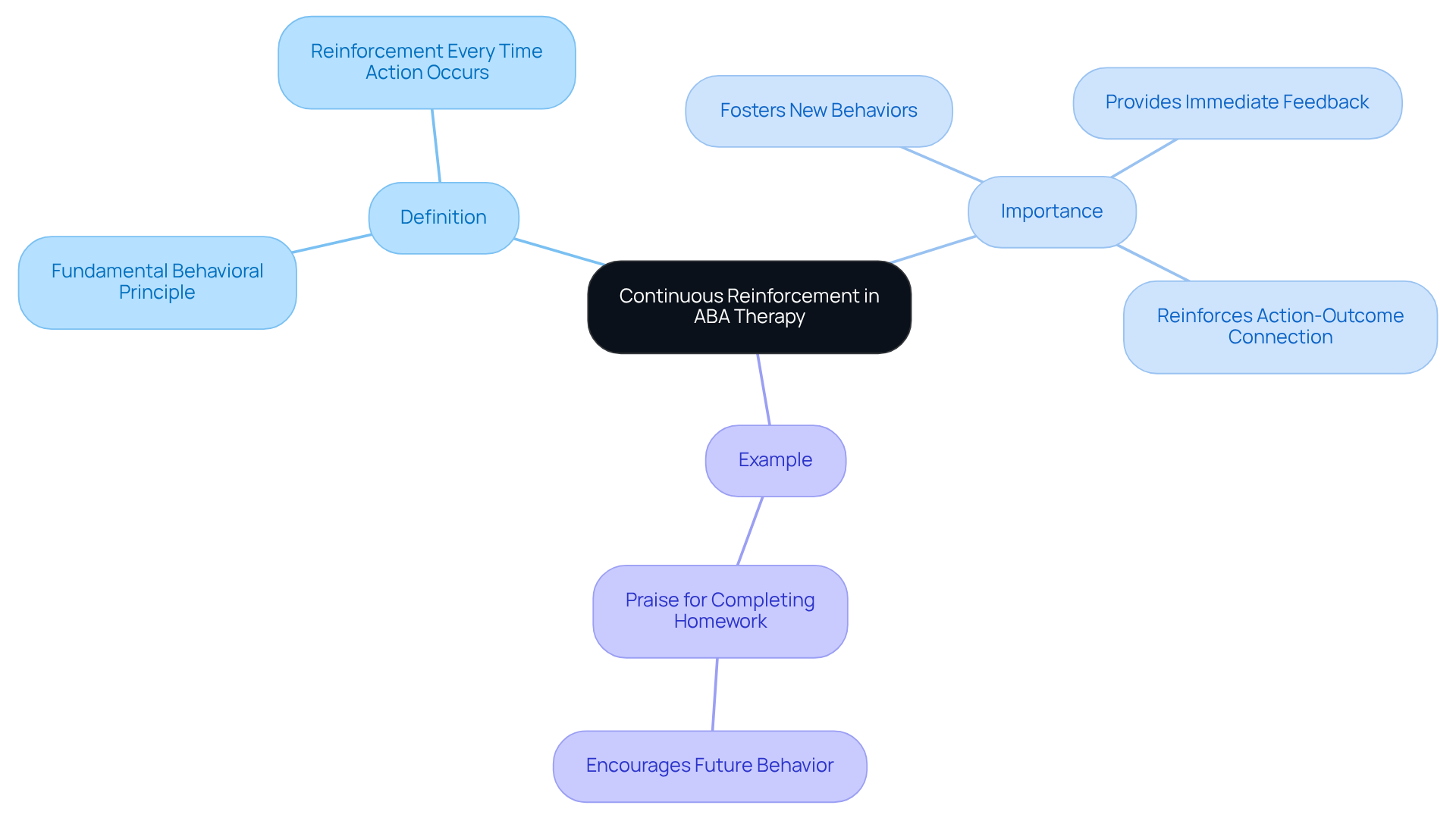
In the field of behavior assessment, constant encouragement stands as a pivotal technique for modifying conduct.
What is continuous reinforcement, when frequently employed alongside reward systems such as intermittent rewards, plays a crucial role in sustaining and enhancing behaviors over time.
This continuous support proves particularly beneficial in early intervention settings, where the establishment of new skills is vital.
By providing consistent encouragement, practitioners can effectively shape responses, demonstrating what is continuous reinforcement, making it an indispensable tool in the repertoire of behavior analysts who assist individuals facing developmental disabilities or behavioral challenges.
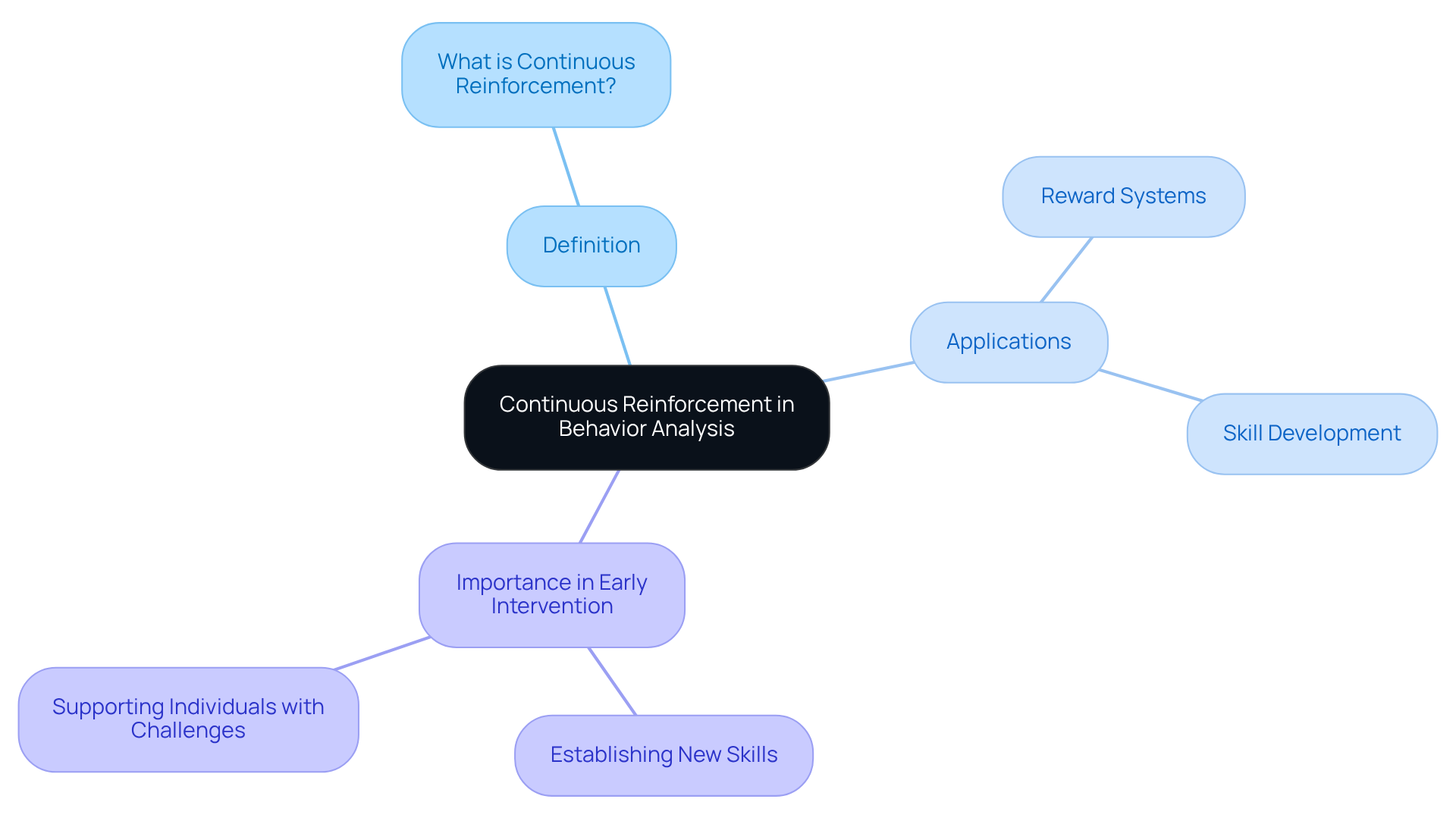
The demand for Board Certified Behavior Analysts (BCBAs) is projected to surge by 25% over the next five years, underscoring the critical need for ongoing support in behavioral analysis. This principle, rooted in the groundbreaking research of B.F. Skinner during the mid-20th century, has proven essential in various fields, particularly in education and therapeutic practices. Skinner's innovative studies with rats and pigeons illustrated how behaviors could be systematically shaped through rewards, establishing the foundation for operant conditioning.
By the 1960s and 1970s, ongoing support became a vital component of Applied Behavior Analysis (ABA) therapy, especially in teaching new skills to individuals with autism and other developmental disorders. This historical evolution highlights the enduring significance of ongoing support in behavior change, marking it as a fundamental aspect of effective intervention strategies.
As the field continues to evolve, the increasing demand for BCBAs not only enhances educational outcomes but also opens avenues for higher salaries and leadership roles within the profession. This trend emphasizes the importance of ongoing support in empowering individuals with Autism Spectrum Disorder (ASD) to achieve greater independence and success. Moreover, it creates new career opportunities for professionals in ABA therapy, reinforcing the need for reliable recruitment platforms like Hire ABA to meet these challenges.
Are you facing difficulties in hiring qualified professionals? Consider how Hire ABA can facilitate your recruitment process, ensuring that you have the right support in place to make a meaningful impact in the lives of those you serve.
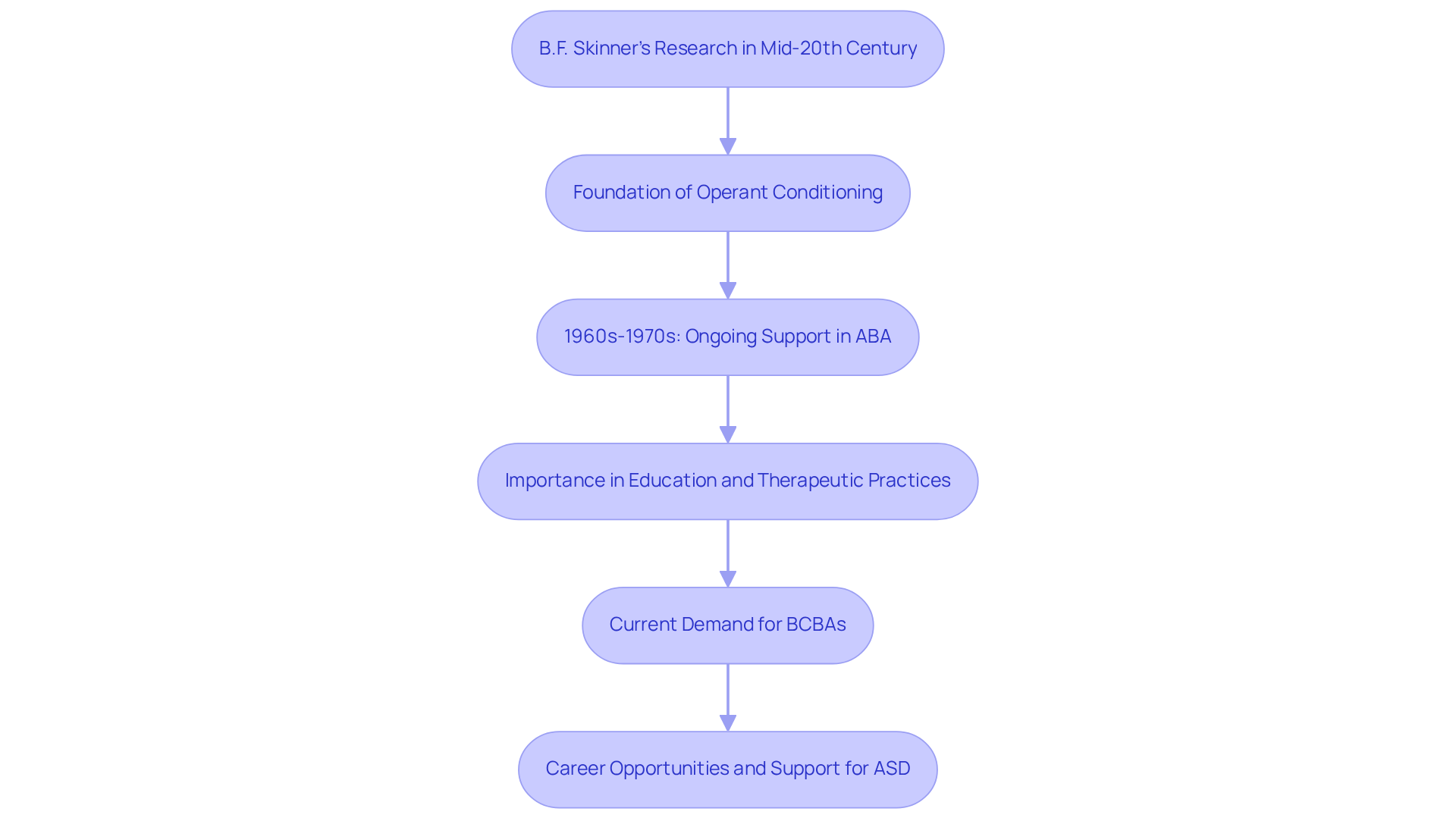
In ABA therapy, what is continuous reinforcement is characterized by three key elements: immediacy, consistency, and clarity.
Immediacy pertains to the swift provision of support right after the desired action takes place, greatly enhancing the connection between the action and its reward. As Yitz Diena points out, "Prompt delivery of support enhances the link between actions and reward," highlighting the significance of this swift feedback in assisting individuals in understanding the relationship between their actions and the favorable results that ensue.
Consistency is equally essential; to understand what is continuous reinforcement, it must be offered each time the action is displayed to effectively establish new patterns. This steadfast approach fosters a dependable learning environment where individuals can anticipate the outcomes of their actions.
Clarity requires ensuring that the person understands which specific action is being reinforced. Clear communication and feedback are crucial in this regard, as they help individuals comprehend expectations and reinforce desired actions.
For instance, a case study on positive incentives demonstrates how rewarding a child with a favored activity after completing a task can enhance their motivation and understanding of the consequences of actions. Together, these traits make ongoing support a powerful method in ABA therapy, particularly in the early phases of behavior modification, where understanding what is continuous reinforcement is vital for success.
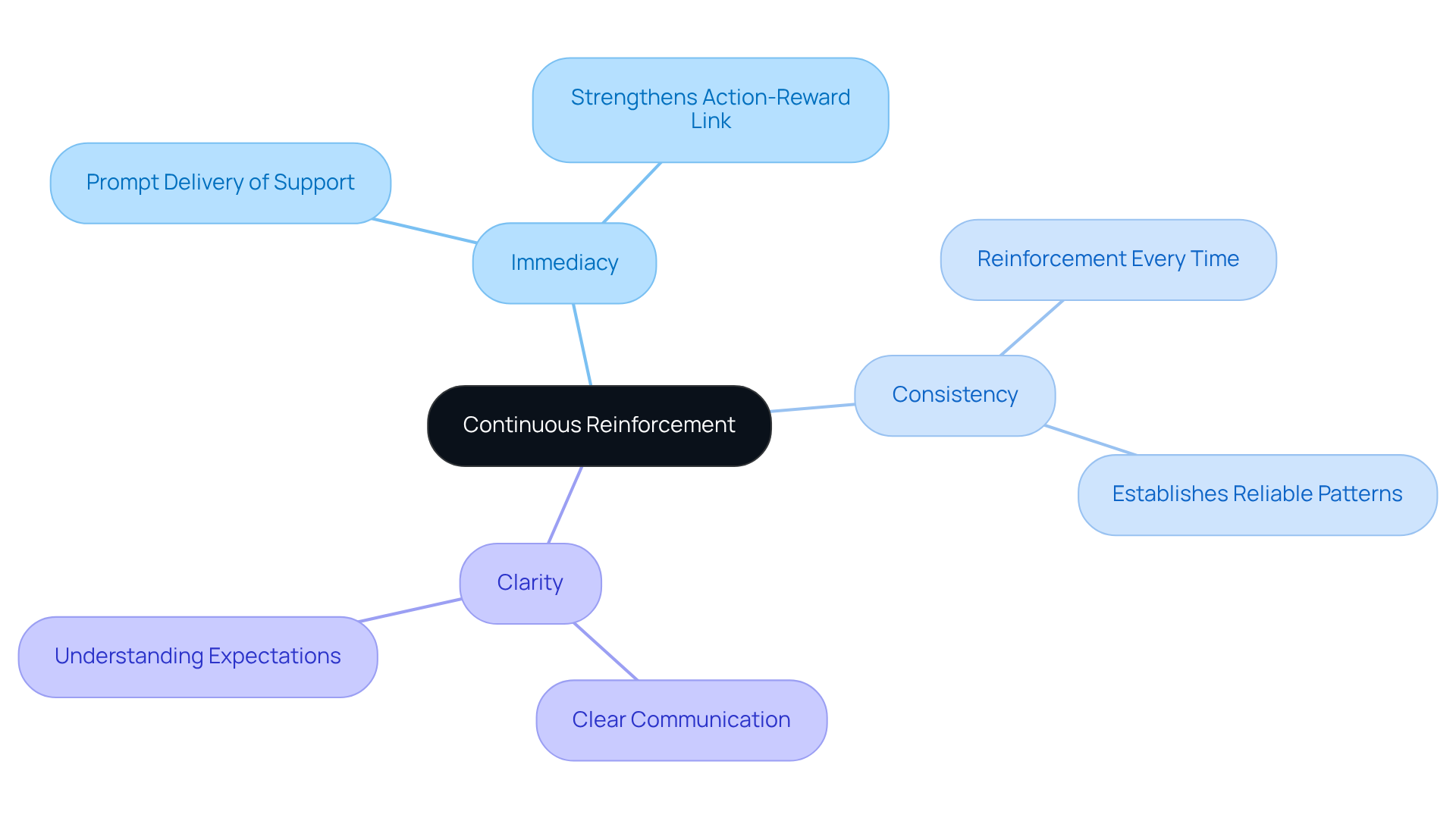
Continuous encouragement is essential across various environments, including schools, clinics, and home settings. Consider this:
These practical applications highlight how continuous reinforcement effectively shapes behaviors across different contexts, ultimately enhancing learning and development.
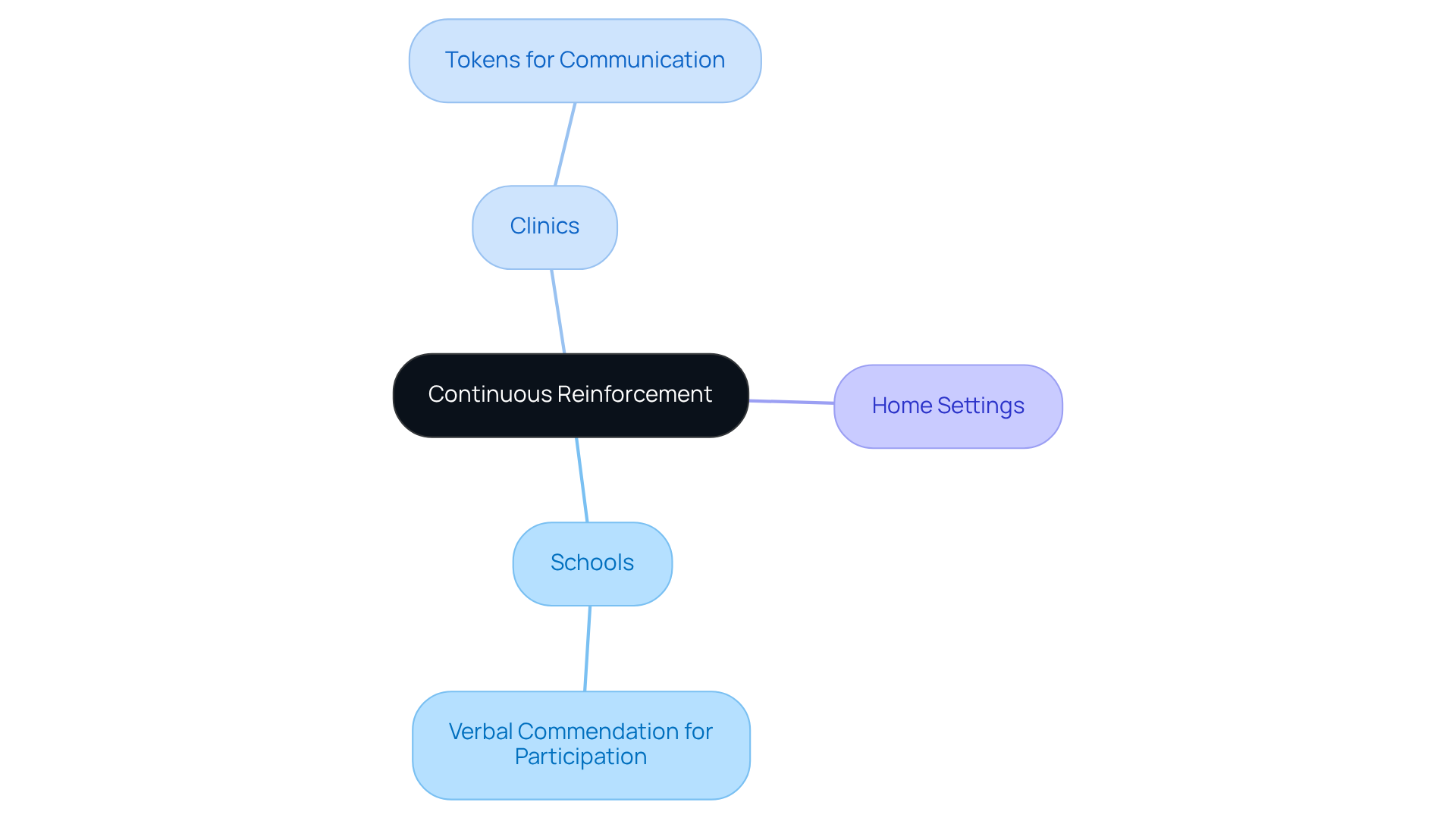
Continuous reinforcement plays a vital role in Applied Behavior Analysis (ABA) therapy, serving as a foundational element for promoting desired behaviors through consistent and immediate feedback. By reinforcing actions each time they occur, this method not only establishes new habits but also fosters a deeper understanding of the relationship between behavior and positive outcomes. The effectiveness of continuous reinforcement is particularly pronounced during the initial stages of learning, making it an indispensable tool for practitioners working with individuals facing developmental challenges.
Key insights from the discussion highlight the historical significance of continuous reinforcement, tracing its origins back to B.F. Skinner's research and its evolution into a crucial strategy in ABA therapy. The characteristics of immediacy, consistency, and clarity are essential for maximizing the impact of this approach, ensuring that individuals clearly understand the behaviors being reinforced. Practical applications across educational and therapeutic settings further demonstrate the versatility and effectiveness of continuous reinforcement in shaping positive behaviors.
As the demand for qualified behavior analysts continues to grow, embracing continuous reinforcement is more important than ever. Professionals in the field are encouraged to leverage this powerful technique, not only to enhance learning outcomes but also to empower individuals with the skills they need for greater independence. By prioritizing consistent and clear reinforcement strategies, practitioners can make a meaningful difference in the lives of those they serve, ultimately contributing to a more supportive and effective learning environment.
What is continuous reinforcement in ABA therapy?
Continuous reinforcement in Applied Behavior Analysis (ABA) refers to a behavioral principle where a desired action receives reinforcement every time it occurs. This method is effective for fostering new behaviors by providing immediate feedback, reinforcing the connection between the action and its positive outcome.
How does continuous reinforcement work?
Continuous reinforcement works by consistently providing a reward or positive feedback each time a desired behavior is exhibited. For example, if a child receives praise every time they complete their homework, this consistent reinforcement encourages them to repeat the behavior in the future.
Why is continuous reinforcement important in behavior analysis?
Continuous reinforcement is important in behavior analysis because it provides ongoing support that is crucial for establishing new behaviors, particularly during the initial stages of learning. It helps in shaping responses and modifying conduct effectively.
In what contexts is continuous reinforcement particularly beneficial?
Continuous reinforcement is particularly beneficial in early intervention settings, where establishing new skills is vital. It is also a key technique used by behavior analysts to assist individuals facing developmental disabilities or behavioral challenges.
How does continuous reinforcement relate to reward systems?
Continuous reinforcement is often employed alongside reward systems, such as intermittent rewards, to sustain and enhance behaviors over time. It serves as a foundational technique for modifying conduct and encouraging positive behavior.
Our expert recruitment strategies and AI-driven sourcing ensure that you receive top-notch candidates quickly, without compromising on quality. Whether you’re looking for BCBAs, Clinical Directors, or RBTs, we’ve got you covered.